Related Research Articles

Richard Cromwell was an English statesman who was the latter Lord Protector of the Commonwealth of England, Scotland and Ireland and son of the first Lord Protector, Oliver Cromwell.

Charles II was King of Scotland from 1649 until 1651, and King of Scotland, England and Ireland from the 1660 Restoration of the monarchy until his death in 1685.

Dumfries is a market town and former royal burgh within the Dumfries and Galloway council area of Scotland. It is located near the mouth of the River Nith into the Solway Firth. Dumfries is the traditional county town of the historic county of Dumfriesshire. Dumfries is nicknamed Queen of the South. The nickname has also given name to the town's professional football club. People from Dumfries are known colloquially in Scots language as Doonhamers.

Caerlaverock Castle is a moated triangular castle first built in the 13th century. It is located on the southern coast of Scotland, 11 kilometres (6.8 mi) south of Dumfries, on the edge of the Caerlaverock National Nature Reserve. Caerlaverock was a stronghold of the Maxwell family from the 13th century until the 17th century, when the castle was abandoned. It was besieged by the English during the Wars of Scottish Independence, and underwent several partial demolitions and reconstructions over the 14th and 15th centuries. In the 17th century, the Maxwells were created Earls of Nithsdale, and built a new lodging within the walls, described as among "the most ambitious early classical domestic architecture in Scotland". In 1640 the castle was besieged for the last time and was subsequently abandoned. Although demolished and rebuilt several times, the castle retains the distinctive triangular plan first laid out in the 13th century. Caerlaverock Castle was built to control trade in early times.

George Monck, 1st Duke of Albemarle, KG was an English soldier and politician, and a key figure on both sides of the English Civil War, as well as the Restoration of the monarchy to King Charles II in 1660.

James FitzJames Butler, 2nd Duke of Ormonde, (1665–1745) was an Irish statesman and soldier. He was the third of the Kilcash branch of the family to inherit the earldom of Ormond. Like his grandfather, the 1st Duke, he was raised as a Protestant, unlike his extended family who held to Roman Catholicism. He served in the campaign to put down the Monmouth Rebellion, in the Williamite War in Ireland, in the Nine Years' War and in the War of the Spanish Succession but was accused of treason and went into exile after the Jacobite rising of 1715.

The Popish Plot was a fictitious conspiracy invented by Titus Oates that between 1678 and 1681 gripped the Kingdoms of England and Scotland in anti-Catholic hysteria. Oates alleged that there was an extensive Catholic conspiracy to assassinate Charles II, accusations that led to the executions of at least 22 men and precipitated the Exclusion Bill Crisis. Eventually Oates's intricate web of accusations fell apart, leading to his arrest and conviction for perjury.

John Hutton Balfour was a Scottish botanist. Balfour became a Professor of Botany, first at the University of Glasgow in 1841, moving to the University of Edinburgh and also becoming the 7th Regius Keeper of the Royal Botanic Garden Edinburgh and Her Majesty's Botanist in 1845. He held these posts until his retirement in 1879. He was nicknamed Woody Fibre.
Colonel John Hewson (Hughson) was a soldier in the New Model Army and signed the death warrant of King Charles I, making him a regicide.
Sir Thomas Lake was Secretary of State to James I of England. He was a Member of Parliament between 1593 and 1626.

Francis Godolphin, 2nd Earl of Godolphin,, styled Viscount Rialton from 1706 to 1712, was an English courtier and politician who sat in the English and British House of Commons between 1695 and 1712, when he succeeded to the peerage as Earl of Godolphin. Initially a Tory, he modified his views when his father headed the Administration in 1702, and was eventually a Whig. He was a philanthropist and one of the founding governors of the Foundling Hospital in 1739.

Lieutenant-General Thomas Erle PC of Charborough, Dorset was an English army general and Whig politician who sat in the House of Commons of England and of Great Britain from 1678 to 1718. He was Governor of Portsmouth and a Lieutenant-General of the Ordnance.
Stephen Vaughan (1502-1549) was an English merchant, royal agent and diplomat, and supporter of the Protestant Reformation.

Sir William Paddy (1554–1634) was an English royal physician.

Sir Andrew Halliday, KH was a Scottish physician, reformer, and writer.

Robert Maxwell, 1st Earl of Nithsdale, was a Scottish nobleman. He succeeded his brother as 10th Lord Maxwell in 1613, and was created Earl of Nithsdale in 1620. General of Scots in Danish-Norwegian service during the Thirty Years' War. A loyal supporter of Charles I and a prominent Catholic, he lost his titles and estates in 1645, dying on the Isle of Man in 1646.

Sir Lucas Pepys, 1st Baronet was an English physician.
Sir William Johnstone, 2nd Baronet of Sciennes and Westerhall was a Scottish landowner and politician who sat in the Parliament of Scotland from 1698 to 1707 and in the British House of Commons between 1707 and 1722.
Dr William Lauder Lindsay FRSE FLS LRCS was a Scottish physician and botanist. As a physician he largely worked in the field of mental health. As a botanist he specialised in lichens.
William Veitch was born on 27 April 1640. He was the youngest son John Veitch, the minister of Roberton, Lanarkshire. He was educated at the University of Glasgow, graduating with an M.A. in 1659. He became a tutor in the family of Sir Andrew Ker of Greenhead. He was licensed to preach by the Presbytery of Lanark in 1664. Having identified himself with the Pentland Rising, he was outlawed, and escaped to Newcastle, where he became chaplain in the family of the Mayor. In 1671 he was ordained to a meeting-house at Fallowlees, a remote spot among the Simonside Hills, Rothbury. From that he removed to Hanamhall, in the same district, and afterwards to Seaton Hall, Longhorsly. Whilst living at the latter place under the assumed name of William [or George] Johnston, he was arrested on 16 January, and sentenced to the Bass Rock 22 February 1679.. Veitch was liberated on 17 July 1680, and returned to Newcastle. He aided Archibald, Earl of Argyll, in his escape from Scotland in 1681. In 1683 he went to Holland, and in 1685 he was again in Northumberland acting as an agent on behalf of Monmouth. Soon afterwards he was settled as minister of a meeting-house at Beverley, Yorkshire. Having returned to Scotland, he was called to Whitton Hall, Morebattle, April 1688. In 1690 he was minister of Peebles, and in September 1694, he was admitted to Dumfries. He demitted on 19 May 1715. His death was on 8 May 1722. In 1705 he presented to the church two communion cups.
References
- ↑ "HUTTON, John II (d. 1712), of Caerlaverock, Dumfries and St. Clement's, Westminster". History of Parliament Online. Retrieved 13 September 2016.
-
 This article incorporates text from a publication now in the public domain : Goodwin, Gordon (1891). "Hutton, John (d.1712)". In Lee, Sidney (ed.). Dictionary of National Biography . 28. London: Smith, Elder & Co. p. 356.
This article incorporates text from a publication now in the public domain : Goodwin, Gordon (1891). "Hutton, John (d.1712)". In Lee, Sidney (ed.). Dictionary of National Biography . 28. London: Smith, Elder & Co. p. 356.
| Parliament of Great Britain | ||
|---|---|---|
| Preceded by William Johnstone | Member of Parliament for Dumfries Burghs 1710–1712 | Succeeded by Sir William Johnstone, Bt |